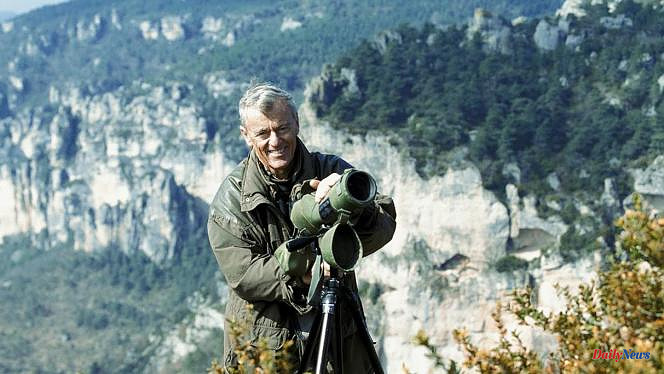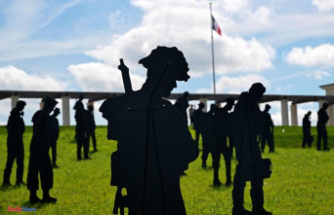Who would have thought that this pharmacist practicing in La Garenne-Colombes (Hauts-de-Seine) in the 1960s and 1970s would become one of the greatest protectors of raptors known throughout the world? The ornithologist, who multiplied vulture reintroduction operations in France, Europe, South and North America, died on January 13, at the age of 84.
Born on August 11, 1938, in Pont-de-Roide (Doubs), he will succeed, in the early 1960s, in reconciling his job as a pharmacist with his new profession as an animal filmmaker. His first film, Pyrenees mountain of eagles, released in 1964 will be followed by about twenty productions including Le Bal des charognards (1984), Les Oiseaux d'Eléonore (1978) shot in Tunisia, Between land and sea (1983), film on the ornithological richness of Aiguillon Bay (Vendée), L'Oued which, in 1972, described the beauty and fragility of sub-Saharan fauna, including the very rare bald ibis.
He also directed several films in South America: Under the Wings of the Condor in 1977, Falklands, Papuan Islands in 1981 and especially Condors in 1991, the fruit of three years of filming in Argentina, Peru, Chile and California. In 1985, Le Retour du Bouldras told the extraordinary adventure of the reintroduction of griffon vultures in the Tarn and Jonte gorges. He then directed a film in 1993 on the kestrels which colonized the most beautiful monuments of Paris (the Eiffel Tower, Notre-Dame and the dome of the Invalides), then contributed as chief operator to the shooting of Jacques Perrin's film, Le Peuple. migrant, in 2001.
Backup programs
The great work of Michel Terrasse's life lies in the creation in 1969 of the Raptor Intervention Fund (FIR), which he runs with his brother Jean-François and hundreds of passionate ornithologists. In the 1960s, owls were still nailed to barn doors, buzzards and vultures were captured and destroyed with jaw traps, and strychnine was used to poison them. Consequently, the number of vultures decreased in France and in Europe.
As soon as the FIR was created, Michel Terrasse launched programs to safeguard and monitor the nests of the peregrine falcon, a species that was highly threatened at the time due to the poisoning of eggs by the chemical DDT or the looting of broods. At the same time, he promotes his films through numerous awareness-raising actions for young and adult audiences thanks to his dynamism and his growing aura.
In the process, the FIR obtained regulatory protection for all raptors in France in 1972 and 1976. The success of these initiatives was such that sections of the FIR were created in Belgium, Switzerland, Italy, Austria, Bulgaria, Spain, Portugal, Greece, Tunisia. Its main objective: to reconstitute viable populations of the four species of scavenger raptors in Europe: the griffon and monk vultures, the bearded vulture and the Egyptian vulture.
This objective has almost been achieved to date. From a few thousand throughout southern Europe, it is currently estimated that more than 100,000 individuals, all species combined, the number of necrophagous birds flying over the mountains of the Old Continent. It was under the impetus of Michel Terrasse that the technique of feeding plots was used in the Causses and then gradually throughout Europe by finding a way to modify European regulations which prohibited leaving domestic herbivores dead. in the open air for sanitary reasons.
Mass grave technique
This technique of mass graves is very ecological because not only does it provide a source of food for scavenger vultures, but it also avoids the transport of animal carcasses and their incineration. It is this action that will save the raptors thanks to the help of mountain breeders. Its action is not limited to the protection of large vultures: Michel Terrasse undertakes to ban the use of bromadiolone, a dangerous rat poison, with success in the meadows of Auvergne and Franche-Comté, where red kites nest and winter , threatened species.
Following the merger of the FIR and the LPO in 1998, of which he will be vice-president, he becomes president of the Foundation for the conservation of vultures and vice-president of the Foundation for the conservation of black vultures. It promotes, advises, disseminates the examples tested in France to contribute to the conservation of all species of vultures in the world, in particular condors in South America and the United States, develops action plans to rehabilitate necrophagous species in Africa and India, where once the populations were the most flourishing in the world.
Paradoxically, at the end of his life, Michel Terrasse considered that it was easier to save populations of vultures and large raptors in Europe, all threatened sixty years ago, than to halt the inexorable decline of small insectivorous passerines confronted with the drastic reduction in insect populations, a consequence of intensive agriculture and various sources of pollution.












